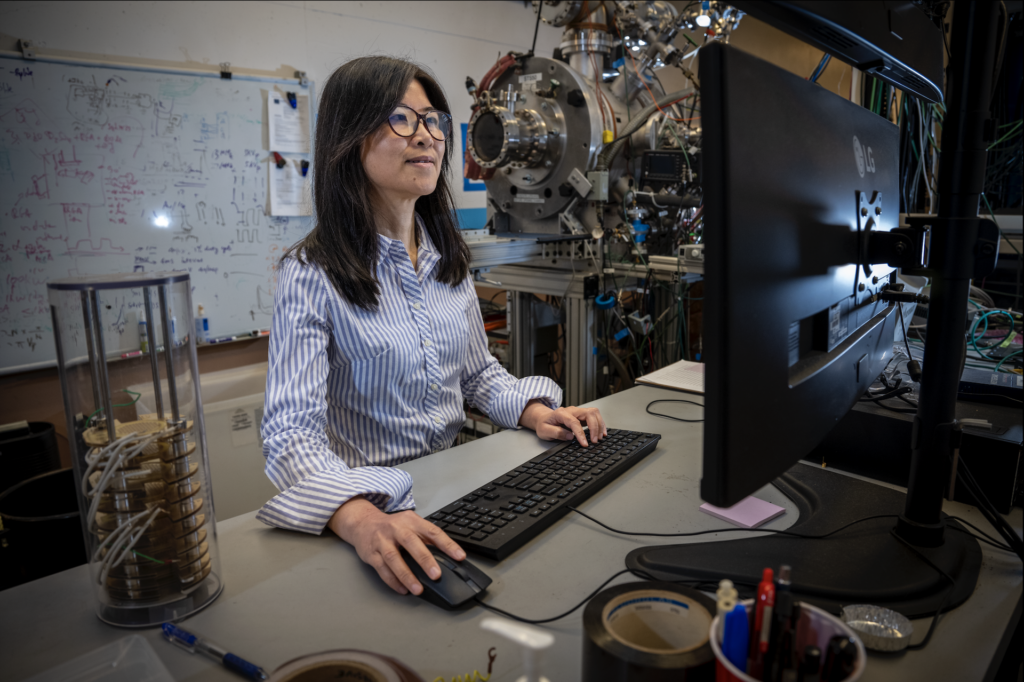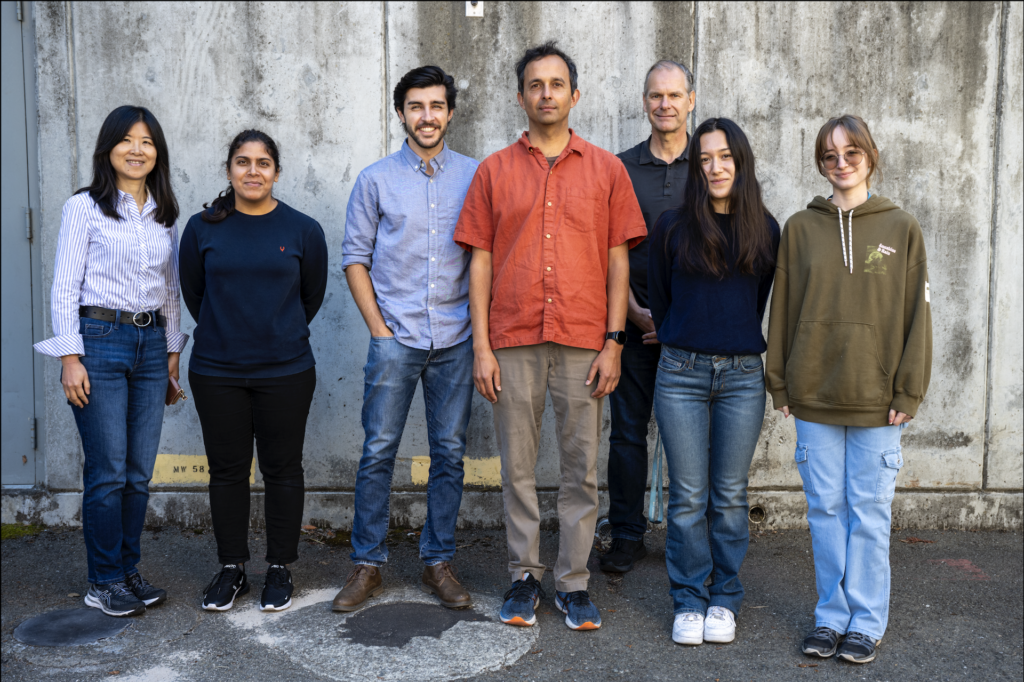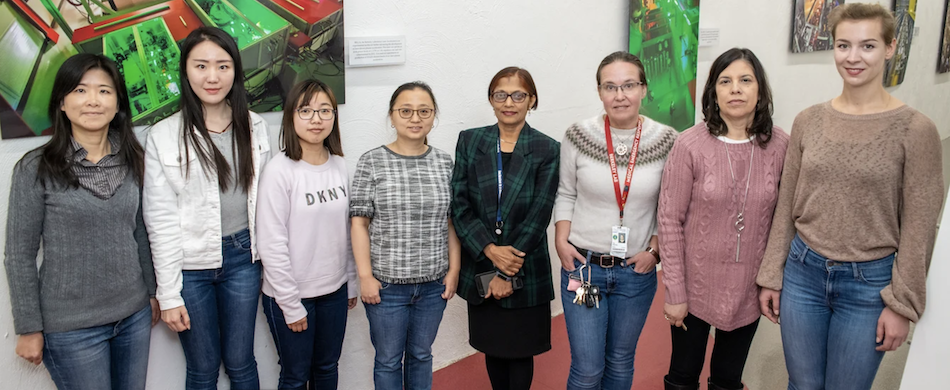A highly respected and internationally renowned scientist, Qing Ji, a staff scientist in the Accelerator Technology & Applied Physics (ATAP) Division at Berkeley Lab, was recently appointed to lead ATAP’s Berkeley Accelerator Controls & Instrumentation (BACI) Program.
The appointment recognizes Ji’s significant contributions to advancing accelerator science, especially in advanced accelerator concepts, ion beam technology, ion source applications, accelerator front-ends, neutron generators, and semiconductor manufacturing, as well as her commitment to advancing the mission and values of the Lab.
Ji says her vision for BACI is “to continue building upon the foundation the program has achieved in developing advanced controls and instrumentation that support the accelerator community while developing advanced acceleration technologies.”
“I see us becoming an incubator for the Lab’s other divisions and programs, as well as continuing to successfully collaborate on projects with our colleagues across the national lab complex and other institutions to improve the capabilities of today’s and future accelerators while also making them more energy-efficient and cheaper to construct and operate.”
She adds that BACI’s work is important for projects including upgrading Berkeley Lab’s Advanced Light Source, the Proton Improvement Plan II at Fermi National Accelerator Laboratory, Argonne National Laboratory’s Wakefield Accelerator Facility, and SLAC National Accelerator Laboratory’s Linac Coherent Light Source II, the world’s most powerful X-ray laser.
Formed in 2015, BACI is a world-leading center for advanced radio frequency instrumentation design and engineering, ultrahigh precision controls, and high-dynamic range beam instrumentation. The program has a successful track record of delivering on accelerator projects (domestically and internationally) and has made significant contributions to advancing accelerator research and development and facilities worldwide.
According to Ji, building on ongoing collaborations, three areas offer new opportunities for BACI.
“The first area, and one that I’m very excited about, is the opportunity to work with our colleagues at Brookhaven National Laboratory on the development of the Electron-Ion Collider (EIC) in the area of LLRF controls.” The EIC is the latest particle accelerator to be constructed in the U.S. Akin to a CT scanner for atoms, it will allow researchers to peek deeper inside the nucleus, providing a “better understanding of the strong nuclear force and could lead to breakthroughs in nuclear physics and the creation of new technologies.”
The second, adds Ji, is to develop the program’s HiRES beamline as a test facility for accelerator components, such as injectors, low-level radio frequency timing, and ultrafast electron diffraction techniques. It will serve as a platform for developing and applying machine learning-based control, which is a core BACI strength with broad importance to improve further the performance of the beamline and all accelerators and for coherent laser combination techniques that could help usher in the next generation of laser-plasma accelerators.
“And, should proposed work towards a muon collider go ahead following the recommendations from P5 (the Particle Physics Project Prioritization Panel, which makes recommendations for the next decade of US particle physics), an additional priority area for us will be to advance radio frequency design and engineering to support development of this concept, which will add to BACI’s work supporting proton and advanced accelerator paths towards a more efficient, lower-cost, greener future accelerator,” she says.

Ji notes that steering BACI through these exciting projects and, for example, advancing qubit control for quantum computers, helping to mitigate quenching in superconducting magnets being developed by the Lab’s Superconducting Magnet Program, or by providing advanced controls and diagnostics to the Berkeley Lab Laser Accelerator (BELLA) Center “will not be about having all the answers but enabling the team to find the right solutions.”
“I see my role as providing the team with the support and resources to help them grow and thrive,” she says.
An early start
The desire to gain new knowledge and learn new skills has been a driving force for Ji since she was a child growing up in a small town in Fujian Province in southeastern China before her family moved to Nanjing at the age of six.
“From a very early age, I was curious about how and why things worked. My father, a professor of philosophy at the local college, would always share with my brother and me the new scientific discoveries and technologies he had read about when preparing materials for his lectures. These often covered a range of subjects, including physics, chemistry, and the life sciences.”
She notes that growing up, her parents treated her and her brother equally, and this experience has instilled in her the importance of exposing children, especially girls, to science at an early age. “It is essential that we encourage girls and young women to go into STEM subjects and provide an environment that fosters a culture of inclusivity to keep young female scientists and engineers in STEM fields.”
Ji says that this formative experience as a child led to a life-long love of science and her desire to study STEM subjects. “From elementary to middle school, I was always top of my class in math, and so I initially wanted to become a mathematician.”
However, when it came time to nominate a major—which is required in China before taking the college entrance exam—Ji decided to study theoretical physics instead, enrolling for a Bachelor of Science in Nuclear Physics at the University of Science and Technology of China at Hefei in Anhui province, in 1989.
She notes that being the only girl in the class of about 30 students was “initially quite daunting.” However, a female professor was assigned as her mentor, who she says “ensured the boys included me in all the activities—which they made a point of doing—and helped me feel that I belonged.”
During her undergraduate degree, Ji worked on electron energy-loss spectroscopy, a type of electron microscopy in which a beam of electrons with a narrow range of energies passes through a sample to create spectra that provide information on the composition and structure of the sample.
“Sometimes, we needed to run the experiments over 24 hours, which meant staying overnight in the lab and was a lot of fun,” she says. “The professor overseeing the work was very encouraging, so I stayed at the lab and took a master’s degree.”
In China, master’s degrees are three years long. This, says Ji, allowed her to work with other graduate students and professors in the laboratory. “The hands-on experience I gained in the lab kindled my interest in experimentation, and being exposed to the team dynamics of the lab made me decide to move from theoretical to experimental physics.”
A standard-bearer with a commitment to the Lab’s mission and values
Before taking up the role at BACI, Ji was deputy head of ATAP’s Fusion Science and Ion Beam Technology (FS&IBT) program, a position she took up in 2019. As deputy of FS&IBT, she assisted in managing relationships with external collaborators and government funding agencies and ensuring the program’s operational efficiency, including budgets, funding, workforce planning, and environment, health, and safety.
“I’m always looking for a new direction, and the role at FS&IBT exposed me to strategic planning and an opportunity to develop my skill set further,” she says. “The position also involved mentoring students, including interns, graduates, post-baccalaureate, and postdoctoral fellows, which is very important to me; I’ve had some great mentors during my career, and it’s important to pass that on to others.”

According to Thomas Schenkel, a senior scientist who heads FS&IBT, Ji has “an extensive bandwidth of hands-on experimental physics experience ranging from atomic physics to semiconductor processing and particle accelerator R&D.”
“Qing is also highly effective in running complex projects, including multi-laboratory collaborations with tight deadlines and demanding milestones. She has developed leadership and management knowledge and skills, which will serve her well in her new role leading BACI.”
Ji started her career at Berkeley Lab as a graduate student research assistant in 1998, working on developing focused ion beam techniques for maskless lithography processes. She joined ATAP’s FS&IBT Program as a research scientist in 2005 after receiving her Ph.D. in electrical engineering from the University of California, Berkeley, and conducting postdoctoral research on an integrated focused ion beam and scanning electron microscopy dual beam system at Harvard University. In 2016, she was appointed a staff scientist.
During this time, she has won several awards, most notably the Berkeley Lab Director’s Achievement Award for scientific excellence in applications of ion sources and beam transport systems, which she received in 2018. She was on the team awarded the 2012 R&D 100 Award for developing a High Output Neutron Generator. She also holds eight patents.
In addition to her outstanding contributions to science, Ji has also been a strong advocate for Inclusion, Diversity, Equity, and Accountability (IDEA), as well as an active proponent of ATAP’s outreach activities, encouraging children, especially girls, to pursue careers in science, technology, engineering, and math (STEM) subjects. In recognition of her scientific achievements and work to advance IDEA principles and practices at the Lab, she was honored with the Women @ The Lab award in 2018.

Ji has become a standard-bearer for research excellence and team science and a highly-valued, sought-after researcher. She has contributed to projects across the U.S. Department of Energy (DOE) complex, including roles in Fermilab’s Project X ion source, beam transport, and in the development of a radio frequency quadrupole, a vital component of a linear accelerator that focuses and accelerates a continuous beam of charged particles with high efficiency.
“I have been very fortunate to have worked with researchers from nearly all the division’s programs and have been the principal investigator, work lead, and a key scientific and technical advisor for a wide range of projects,” she says.
This work has, amongst other things, led to the development of a compact laser-driven ion beam accelerator for discovery plasma science, a self-switching metal-insulator coating to protect high-temperature superconducting magnets from quenching, and a microelectromechanical systems-based compact ion accelerator, which received funding from the highly competitive DOE’s Advanced Research Projects Agency-Energy. She was also the co-principal investigator on a project to develop advanced adaptive control systems for compact accelerators, which fostered collaborations with BACI and Los Alamos National Laboratory.
Arun Persaud, a staff scientist at ATAP who has taken over as deputy of FS&IBT, has worked with Ji since she joined the Lab. “Qing has always been very dedicated to the projects she worked on and the colleagues she worked with,” he says. “It has been a pleasure to work with, and I look forward to working on more projects with Qing in the future.”
Ji’s wide-ranging experience of working with researchers from different fields has equipped her with expertise that spans theoretical and experimental physics to computational techniques.
“I am excited to work with Qing in her new role,” says ATAP Division Director Cameron Geddes. “With her research management and strategic planning skills and commitment to improving diversity, equity, and inclusion practices, I’m confident she will be a strong leader in the success of ATAP’s programs and advancing the Lab’s missions and values.”
Learn More
- Ji, Q., Afridi, K. K., Bauer, T., Giesbrecht, G., Hou, Y., Lal, A., Ni, D., Persaud, A., Qin, Z., Seidl, P., Sinha, S., and Schenkel, T. “Beam power scale-up in micro-electromechanical systems based multi-beam ion accelerators,” Review of Scientific Instruments 92, 103301 (2021), https://doi.org/10.1063/5.0058175
- Yang, Z., Martinez, A. C. A., Muley, S. V., Wang, X., Ji, Q., and Anders, A. “Vanadium oxide coatings via cathodic arc deposition to self-regulate current sharing in high-temperature superconducting cables and magnet,” Journal of Applied Physics 128, 055105 (2020), https://doi.org/10.1063/5.0013783
- Steinke, S., Bin, J. H., Park, J., Ji, Q., Nakamura, K., Gonsalves, A. J., Bulanov, S. S., Thévenet, M., Toth, C., Vay, J.-L., Schroeder, C. B., Geddes, C. G. R., Schenkel, T., and Leemans, W. P. “Acceleration of high charge ion beams with achromatic divergence by petawatt laser pulses,” Phys. Rev. Accel. Beams 23, 021302n (2020), https://link.aps.org/doi/10.1103/PhysRevAccelBeams.23.021302
- Ji, Q., Staples, J., Sy, A., Schenkel, T., and Li, D. “Research and development of H- ion source and low energy beam transport for a kaon-neutrino factory,” Review of Scientific Instruments, Volume 83, Issue 2 (2012), 02A718-02A718-3.
